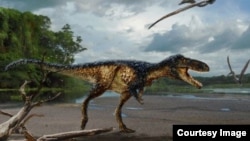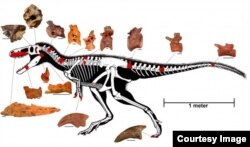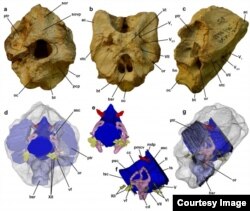Tyrannosaurus rex — the rock star of dinosaurs, the apex predator that beats them all — it turns out was descended from smaller and, well, nerdier stock.
That's the conclusion based on a new fossil find that has helped scientists to bridge the gap between the giant of the movies and its much older, much smaller ancestor. The findings are reported in this week's Proceedings of the National Academy of Sciences.
The ancestor to the T. rex was discovered in a fossil-rich area of Uzbekistan desert called the Bissekty formation. The research team was made up of scientists from the University of Edinburgh, the Smithsonian National Museum of Natural History and the Russian Academy of Sciences.
It's all between the ears
Their key find was a well-preserved brain case about the size of a softball — one of the first ever found from the mid-Cretaceous period about 100 million to 80 million years ago.
Scientists already had the fossilized remains of what would become T. rex from the early Cretaceous — named Timurlengia, the creatures were about the size of a horse. However, no clues existed to suggest how they evolved to become the giant top-level predators of the late Cretaceous.
The newly discovered fossil is the link between the two, and scientists dubbed it Timurlengia euotica, which in the strange arcana of paleontology means “well eared.” That is crucial because it shows that the biggest difference between the new species and Timurlengia wasn't its brawn, but its brain. In other words, it shows that this mid-sized predator spent 20 million years getting smart.
"The ancestors of T. rex would have looked a whole lot like Timurlengia, a horse-sized hunter with a big brain and keen hearing that would put us to shame," said Dr. Steve Brusatte, a co-author from the University of Edinburgh. "Only after these ancestral tyrannosaurs evolved their clever brains and sharp senses did they grow into the colossal sizes of T. rex. Tyrannosaurs had to get smart before they got big."













